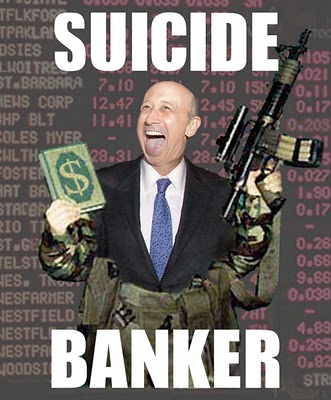London banks were on high alert last week as Max Keiser – the dark lord of financial hellraising – arrived in London to do what he does best: Sacrifice the sacred cows of finance orthodoxy. It’s fitting that he chose to do so in a pub down an alley in London Bridge – The south bank has long been a place of covert speakeasies where villains, pirates and heretics might slag off the king and preach rebellion among the drunken rabble. The event was a fundraiser in aid of Resonance FM, London's alternative arts radio station. Needless to say, it was awesome, and yes, I was drunken rabble.
 |
| DARK LORD RAP: MAX RAGES AGAINST THE MACHINE |
Max Keiser is in intriguing guy. I don’t claim to know his background in any depth, but the quoted back story says he was 1) initially a stockbroker, 2) then an entrepreneur that started the Hollywood Stock Exchange, (a platform for buying and selling film rights, later sold to the huge brokerage Cantor Fitzgerald) and 3) an entertainer that carved out a media career in fiery financial commentary. For those who haven't seen Max in action, he's one of the most outspoken critics of banking practice. He cuts a compelling figure, using a background in the financial industry as a platform from which to advance ideas that are serious no-go areas in mainstream finance chat… stuff like questioning the entire basis of modern monetary systems and advocating that senior bankers should be burnt at the stake.
If this stuff was coming from the standard academic commentator, it would probably sound crap, but Max has made an artform out of passionate advocacy of deeply heretical points of view. Where some people would sound preachy and self-righteous, Max just sounds indignant, pissed off, and funny to boot. He has what many critical academics lack – an opportunistic flair and a talent for entertainment. It’s very seldom that someone can make stand-up comedy out of financial commentary, whilst simultaneously making you deeply question things. He’s both a joker with a mischievous flame and an underdog hyena who cares about injustice. He doesn't claim to be pure, and the fact that he’s been out and tried the system gives him clout.
Financial terrorists
 |
| MY MATE LLOYD |
Max is certainly controversial. In fact, he's pure leveraged controversy. He likes to refer to senior bankers as 'financial terrorists'. He shoots political correctness in the head with disturbing stories of financial rape and epic incompetence. He told us about 'the suicide trader', a concept he's been dreaming up as the basis for a potential upcoming production: The story goes that there's this trader in the World Trade Centre, watching the planes coming and deciding to stay in his chair betting against aeroplane stocks instead of trying to escape. Methinks that could cause a stir...
Karma-banking
 |
| OUTLAWS: STACY HERBERT & MAX |
I met a hedge fund manager a few months ago who knows and loves Max. This probably supports my point, made in a recent Guardian article, that some of the best hedge fund managers are those that do not give a flying f**k about what they’re supposed to think. Max himself has dabbled in some interesting hedge fund ideas. Back in the early 2000s he started Karmabanque. Although it’s suggested that Karmabanque was a hedge-fund in and of itself, Max has characterised it as a ‘broker of dissent’ – a middleman between hedge funds looking to bet against companies, and activists looking to target companies with campaigns. I haven't been able to drill down into the exact structure of Karmabanque and how effective it was, but it's a thought-provoking idea: Betting against companies with poor social and environmental records and then making them targets of activism to drive down their share prices. Some would call that idea 'market-manipulation'. Others would call it sweet justice, a scheme in the spirit of Robin Hood and other underdog rogues (see Greenpeace article). Theoretically speaking, money made in the process could be steered back into doing something positive, like investing in renewable energy, but in the end it seems Karmabanque was shelved. It now provides an interesting model to consider when designing any future activist hedge funds.
Calling the emperor's new clothes: Buy silver, crash JP Morgan
More recently Max has become known for his 'Buy silver, crash JP Morgan' campaign. Max believes that JP Morgan is deeply exposed to a huge naked short position in silver. If it is true, it means JP Morgan is seriously vulnerable to the price of silver going up too much. He reckons that if enough people try buy silver to force the price up, JP Morgan would be forced to try cover its short position (i.e. reverse it's bet against silver), leading to a runaway 'short-squeeze' (in which they scramble to buy silver to get out of their trading position and in so doing cause the price to skyrocket even more) causing JP Morgan to go bankrupt. Here is the dramatised version:
It’s an interesting theory, and not one that I know enough about to have any particular view on it. Max seems pretty sure of himself though, and the campaign goes on. In any case, he advocates the possession of precious metals as a much better alternative to fiat currencies, which he thinks are all going to shit.
Time will tell if Max is right or wrong, but regardless of what you think of his ideas, it’s great to a have an original voice of dissent challenging orthodoxy. I'm always a supporter of muckrakers that keep the system on its toes, and after an hour or so of standing there listening to him I was cheering like a maniac and thinking ‘ah shit Max, you’re cool, can I come talk to you?’ Then he was swamped with fans and I decided against doing that. Maybe I'll meet him one day and we can compare notes.







